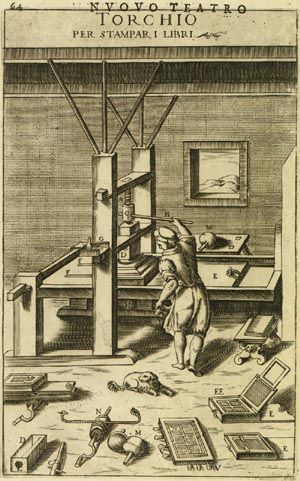Olaus had a right of publication from the Venetian Doge Pietro Lando and the imprimatur of Pope Paul III, so its importance seems to have been recognized.
 |
 |
Probably there were few buyers in Italy for a detailed map of Scandinavia! No matter how many copies of early wall maps were printed, they were difficult to preserve. Like other early wall maps, the Carta Marina became rare soon after it was printed.
Printing large surfaces with the hand presses available in the sixteenth century was difficult. The bed (printing surface) of the hand press was limited to a size that a printer could reasonably ink by hand. The size of the area to be printed was also limited by the need to apply even pressure in printing.
 |
Paper also curtailed the size of the image printed.
 |
Olaus wanted his map to be large, a map that could not be printed on a single sheet, or even on two or four sheets, the format commonly used for larger maps of his time. How could he get the size he wanted? The solution was to use more woodblocks.
![]() Under the Magnifying Glass: Olaus' Carta Marina
Under the Magnifying Glass: Olaus' Carta Marina
©1999-2001 by the Regents of the University of Minnesota, Twin Cities. University Libraries. All rights reserved. Please credit the James Ford Bell Library,
University of Minnesota if you copy or reproduce material from
this page. URL: http://bell.lib.umn.edu/index.html